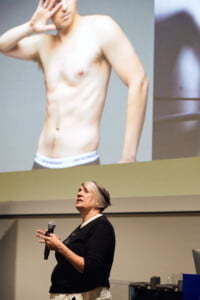Dr Jos Boys explores how everyday social, spatial and material practices come to frame what is ‘normal’ and ‘ordinary’ and questions our assumptions about who gets valued and who doesn’t (in society, in the design of built space and in architecture as a discipline). Watch keynote 2 from Transformations: Action on Equity.
Keynote presentation – Jos Boys
Underpinning our many and various efforts to challenge how we think about gender and equity in architecture are foundational questions about what kinds of bodies are seen to matter in the world. How is it that certain kinds of bodies are assumed normal and unproblematic – whether as building producers or occupiers of built space – whilst others are unconsidered, unnoticed, or noticed only as a ‘problem’? How does bodily difference come to be made concrete in specific and inequitable ways through patterns of marginalisation, denigration and discrimination in architectural processes, and then in access to, and occupation of, built space? How can we unravel the social, spatial and material practices that act to turn ordinary difference into differentiation and inequality?
In this talk Jos explores both how spaces come to be gendered in complex, shifting and deeply intersectional ways; and how we can critique architecture’s often limited framings of the body by instead starting from difference, from valuing the rich bio and neuro-diversity of ‘unruly’ bodies.
Jos Boys works at The Bartlett at University College London, UK. Originally trained in architecture, she was co-founder of Matrix feminist architecture and research collective in the 1980s and one of the authors of Making Space: Women and the Man-made Environment (Pluto 1984). Since that time she has worked as a journalist, researcher, consultant, educator and photographer; and has published several books. Most recently she co-founded The DisOrdinary Architecture Project, bringing disabled artists into architectural education and practice to critically and creatively re-think access and inclusion.
Jos explores how everyday social, spatial and material practices come to frame what is ‘normal’ and ‘ordinary’. She works with others on design interventions that question our assumptions about who gets valued and who doesn’t (in society, in the design of built space and in architecture as a discipline) She is author of Doing Disability Differently: an alternative handbook on architecture, dis/ability, and designing for everyday life (Routledge 2014) and editor of Disability, Space, Architecture: A Reader (Routledge 2017).
CPD
1 formal point on completion of the CPD questions found here. You will receive an email with your responses. This provides the evidence of attendance and completion for the session named at the top of this document. Please keep the response email for your records, it counts as your certificate. The series learning objectives are here.
This CPD is provided at no cost. If you are in a position to donate to Parlour, please consider supporting our ongoing work.
- Photos: Peter Bennetts
Transformations: Action on Equity was the second ABP Symposium, presented by the Melbourne School of Design and Parlour, November 14–15, 2019.




























